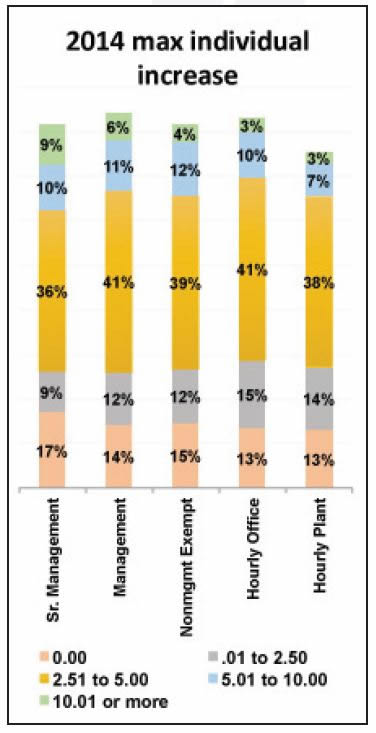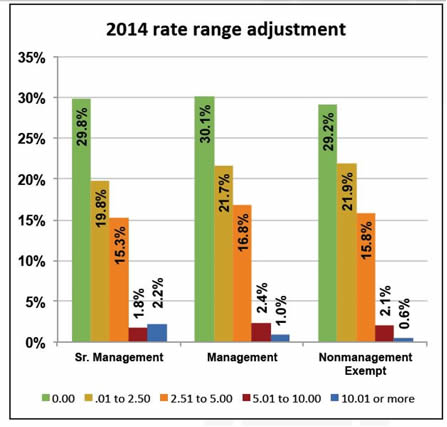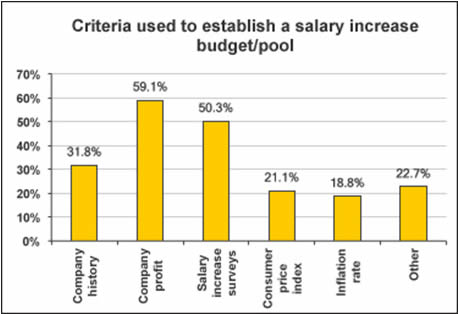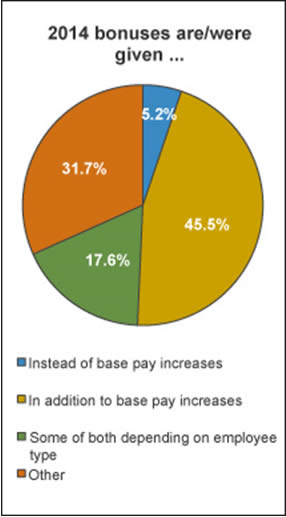Highlights of the survey:
- 18.2% of respondents are awarding merit increases (averaged across all employee types) of up to 2.5% in 2014 and 46.1% are awarding increases of more than 2.5%
- 21% of survey participants awarded an increase of 2.51–3% for “Meets requirements” and 12.9% awarded that amount for “Exceeds requirements.”
- The biggest challenge for respondents is “economy/revenue uncertainty.”
Thanks to all 1,130 people who participated! Here are the results:
2014 Merit Increases
The results of BLR’s 2014–2015 Pay Budget Survey show 18.2% of employers awarding merit increases (averaged across all employee types) of up to 2.5% in 2014 and 46.1% awarding increases of more than 2.5%, with 4.6% awarding increases above 5% of base pay.
The breakdown of employee types shows 15.2% of employers awarded merit increases of up to 2.5% to senior management, 17.5% awarded that amount to management, 17.3% awarded it to nonmanagement salaried exempt employees, 20.3% awarded the same to hourly office employees, and 20.7% awarded up to 2.5% of base pay as an increase to hourly nonoffice employees. Among employers awarding merit increases in 2014, the most commonly awarded amount is 2.5–3%. On average, 35.7% (down from 38.1% in 2013) of responding employers withheld merit increases in 2014.
A peek at the maximum increase tied to a performance scale of 1–5 shows that 21% (up from 19.9% in 2013) of survey participants awarded an increase of 2.51–3% for a score of 2.01–3 (meets requirements) and 12.9% (down from 17.4% in 2013) awarded that amount for a score of 3.01–4 (exceeds requirements). A score of 4.01–5 (far exceeds requirements) resulted in merit increases of 4.51–5% of base pay for 11.1% of survey participants.
At the other end of the scale, 90.2% (down from 95% in 2013) of survey participants did not reward employees who failed to meet the requirements of their jobs and 60.2% didn’t reward employees needing improvement. Of those who did, however, 2.7% awarded up to a half percent of base pay for employees who failed to meet requirements and 7.7% awarded a half-percent increase to employees who need improvement.
Compensation.BLR.com, now thoroughly revved with easier navigation and more complete compensation information, will tell you what’s being paid right in your state–or even metropolitan area–for hundreds of jobs. Try it at no cost and get a complimentary special report. Read More.
2014 General Increases (not tied to performance)

General increases in 2014 are comparable to merit increases, with 19.1% of employers awarding (on average) up to 2.5% in 2014 and 22.7% awarding increases of more than 2.5%, with 2% awarding increases above 5% of base pay.
The breakdown of employee types shows 15.9% of employers awarded general increases of up to 2.5% to senior management, 19.1% awarded that amount to management, 18.9% awarded it to nonmanagement salaried exempt employees, 20.6% awarded the same to hourly office employees, and 21.1% awarded up to 2.5% of base pay as an increase to hourly nonoffice employees. On average, 58.2% (down from 62.5% in 2013) of responding employers withheld general increases in 2014.
2014 Maximum Individual Increases

An average of 12.8% awarded 2.51–3% as their maximum individual increase, though an average of 5% of survey participants awarded more than 10% of base pay. At 14.5% each, hourly office and nonoffice employees were the largest employee groups receiving the former and, at 9%, senior management was the largest group receiving the latter.
2014 Rate Range Adjustments

On average, 21.1% of employers responding to our survey made adjustments of 2.5% or less to their exempt employee rate ranges and 16% made adjustments of 2.51–5% to that same group. Also, 2.1% made adjustments of 5–10%, while an average of 1.3% adjusted their exempt ranges by 10% or more. An average of 59.2% made no adjustment to exempt salary ranges in 2014.
For hourly office workers, 24.4% of the responding employers made rate range adjustments of 2.5% or less and 15.8% made adjustments of 2.51–5%, while 1.7% increased the rate range by 5–10%. An adjustment of over 10% was made by 0.6% and 57.5% made no adjustment to their hourly office employees’ rate ranges.
A little over 21% of the responding employers made rate range adjustments of 2.5% or less to their hourly nonoffice workers and 16.2% made adjustments of 2.51–5%. Rounding out this group, 1.1% of employers made rate range adjustments of 5–10%, while 0.4% made adjustments of over 10% and 60.2% made no adjustment to their hourly nonoffice rate ranges.
2014 Biggest Challenge in Determining Increases
When asked to describe their biggest challenge in determining 2014 salary increases, 41.1% (down from 46% in 2013) of survey participants cited budget constraints as the issue. Myriad other challenges were also noted, including:
- Economy/revenue uncertainty, 13.5%
- Finding usable market data, 9.4%
- Maintaining competitiveness, 8.4%
- Performance management, 8.2%
- How to fairly allocate the increase pool, 5.5%
- Getting senior management approval/buy-in, 4.1%
- Healthcare reform and increasing benefits costs, 3.9%
- Unrealistic employee expectations, 1.8%
2014 Bonuses
While 5.2% of survey respondents offered bonuses in lieu of raises, 45.5% (up from 41.9% in 2013) paid bonuses in addition to salary increases, and 17.6% (down from 19.3% in 2013) awarded some of both depending on employee pay type in 2014.
On average, 46.3% paid bonuses to their exempt employees in 2014, with 16.6% offering amounts of 5% or less and 29.7% awarding amounts greater than 5%. In comparison, 31.8% of those surveyed awarded bonuses to their hourly office workers, with 22.2% offering 5% or less and 9.7% awarding amounts greater than 5%. Hourly nonoffice workers were awarded bonuses by 27.3%, with 20.5% offering 5% or less and 6.7% awarding amounts greater than 5%.
Try BLR’s all-in-one compensation website, Compensation.BLR.com®, and get a complimentary special report, Top 100 FLSA Overtime Q&As, no matter what you decide. Find out more.
A look at the details reveals that 30% of survey participants paid their senior management team members bonuses above 10% of base pay and 18.9% awarded the remainder of their management team members at that level, while 6.7% awarded their nonmanagement exempt employees bonuses of above 10%. At the other end of the spectrum, 29.9% awarded their hourly office employees bonuses of up to 10% and 25.9% of our survey participants awarded their hourly nonoffice employees bonuses of up to 10% of their base pay.

2015 Issues and Challenges
The wage-related issues survey participants expect to have at the end of 2015 include:
|
Trying to keep up with competitors’ wage rates |
40.5% ( up from 27% last year) |
|
Dealing with budget constraints |
18% (down from 24% last year) |
|
Impact of the Affordable Care Act and rising benefits costs |
6.9% (down from 13% last year) |
|
Maintaining company profitability and/or an uncertain revenue stream |
8.8% |
|
Achieving internal equity |
1.9% |
In tomorrow’s Advisor, the rest of the survey results, plus an introduction to the all-things-compensation-in-one-place website, Compensation.BLR.com.


